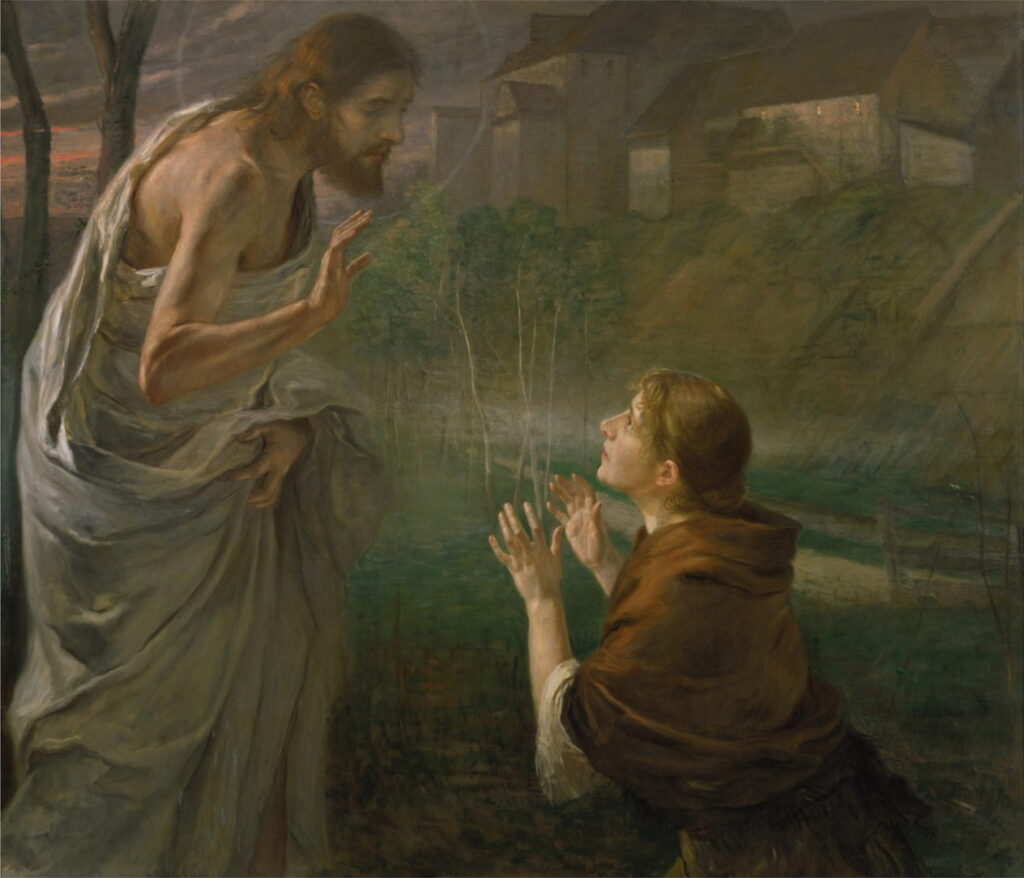Paintings of Mary Magdalene: Gospel times

The stories of three women dominate Christian religious art: the Virgin Mary, Eve, and Mary Magdalene. This weekend I look at paintings of the last of those, the other Mary, and the stories they tell.
Accounts of Mary Magdalene vary across the Gospels, and following confusion introduced by Pope Gregory I in 591. Prior to that, she had been among several women who had supported the ministry of Jesus, possibly after she had seven demons exorcised from her by Jesus Christ. Her role increased at the crucifixion, when she was among the small group of women who attended Jesus and helped his body to be removed from the cross and taken for burial. She reappears in several accounts of the resurrection, when she was an early witness to the empty sepulchre, and told the disciples of Christ’s resurrection.
As if that wasn’t enough, in 591 Pope Gregory I conflated her with Mary of Bethany, and she became cast in the role of a reformed prostitute. That spawned legends about her travelling to southern France, as I’ll show later. Gregory’s conflation wasn’t officially corrected by the Catholic church until 1969, too late to influence any of the paintings here.
William Blake (1757–1827), Mary Magdalene Washing Christ’s Feet (c 1805), pen and ink and watercolor over graphite on paper, 34.9 x 34.6 cm, Philadelphia Museum of Art (Gift of Mrs. William Thomas Tonner, 1964), Pennsylvania, PA. Courtesy of Philadelphia Museum of Art.
William Blake’s Mary Magdalene Washing Christ’s Feet is one of the biblical series he painted for Thomas Butts in about 1803-05. It shows the scene during the supper at the house of Martha and Mary (of Bethany, not Magdalene), that prefigured the Last Supper in several ways. This is told in the gospel of John, chapter 12 verses 1-8:
Then Jesus six days before the passover came to Bethany, where Lazarus was, which had been dead, whom he raised from the dead. There they made him a supper; and Martha served: but Lazarus was one of them that sat at the table with him. Then took Mary a pound of ointment of spikenard, very costly, and anointed the feet of Jesus, and wiped his feet with her hair: and the house was filled with the odour of the ointment.
Then saith one of his disciples, Judas Iscariot, Simon’s son, which should betray him, “Why was not this ointment sold for three hundred pence, and given to the poor?” This he said, not that he cared for the poor; but because he was a thief, and had the bag, and bare what was put therein. Then said Jesus, “Let her alone: against the day of my burying hath she kept this. For the poor always ye have with you; but me ye have not always.”
Presumably the man sat in the centre, wearing blue, is intended to be Lazarus; Mary and Jesus look awkward together: it has been proposed that this results from meanings that Blake attached to left and right, but here it’s almost inevitable given the composition. This does, though, provide a full view of the curved and compacted figure of Mary, and her wiping of Jesus’ feet using her luxuriant and curly hair.
Jean Béraud (1849–1935), Mary Magdalene in the House of Simon the Pharisee (1891), oil on canvas, 104 x 131 cm, Musée d’Orsay, Paris. Wikimedia Commons.
Mary Magdalene in the House of Simon the Pharisee (1891) is one of Jean Béraud’s more extraordinary paintings, and proved highly controversial at the time. The painting (and its title) refers to a story from the ministry of Jesus Christ, in which Jesus was invited to dine with a Pharisee. A woman who had lived a sinful life, sometimes assumed to have been Mary Magdalene, came, wet Jesus’ feet with her tears, and dried them with her hair before anointing them with perfume.
Christ and Mary Magdalene have been transplanted into a dinner attended instead by many prominent figures in the arts of the day. Among those identified are Hippolyte Taine (1828-1893), Eugène Chevreul (1786-1889), Alexandre Dumas the younger (1824-1895), Dr Adrien Proust (1834-1903), and Béraud himself.
Mary Magdalene features in a great many paintings of the Deposition of Christ’s body from the cross.
Lovis Corinth (1858–1925), The Deposition (1895), oil on canvas, 95 × 102 cm, Wallraf-Richartz-Museum, Cologne. Wikipedia Commons.
The Deposition (Descent from the Cross) (1895) was one of Lovis Corinth’s major paintings from his early days in Munich, and won a gold medal when exhibited in the Glaspalast in Munich that year. It shows the traditional station of the cross commemorating the lowering of the dead body of Christ from the cross, attended by Joseph of Arimathea and Mary Magdalene.
This work is another thoroughly modern approach to a classical theme, in its framing, composition, and the faces. Its close-in cropped view suggests the influence of photography, and the faces shown appear contemporary and not in the least historic. These combine to give it the immediacy of a current event, rather than something that happened almost two millennia ago.
Another established tradition is that Mary Magdalene, either at the dinner in the house of Simon the Pharisee, or because of her role in the Deposition, is the bearer of myrrh. This is strongest in the eastern tradition, where she has been held as virtuous, and honoured as an equal to the Apostles.
Andrea Solari (1460–1524), Mary Magdalen (c 1524), oil on panel, 75.5 x 59.2 cm, Walters Art Museum, Baltimore, MD. Wikimedia Commons.
Perhaps the most detailed account of Mary as Myrrhbearer is Mary Magdalene from about 1524, in the manner of Leonardo da Vinci and attributed to Andrea Solari. She is here transferring myrrh from a maiolica pharmacy jar to a smaller vessel, as if preparing to take it to embalm the body of Christ. This cannot, of course, be pure myrrh resin which is a solid, but a tincture in alcohol.
Viktor Mikhailovich Vasnetsov (1848–1926), Maria Magdalene (1899), media and dimensions not known, State Russian Museum, Saint Petersburg, Russia. Wikimedia Commons.
One modern example of the eastern tradition is Viktor Mikhailovich Vasnetsov’s striking Mary Magdalene from 1899. Maybe the trees in its background are intended to be myrrh-producing too.
Although the Gospels aren’t consistent, Mary Magdalene is described as playing a key role in several episodes of the Resurrection.
John Roddam Spencer Stanhope (1829–1908), Why seek ye the living among the dead? (St Luke, Chapter XIV, verse 5) (1896), oil on paper, 15.3 × 22.8 cm, location not known. Wikimedia Commons.
John Roddam Spencer Stanhope’s Why seek ye the living among the dead? (St Luke, Chapter 14, verse 5) (1896) refers to the version in which Mary Magdalene and companion(s) return to Christ’s tomb, only to find its door open and the tomb empty. They are then greeted by two men who inform them that Christ has risen from the dead. Stanhope depicts this in the style of a frieze, the four figures arranged across the painting in a single parallel plane. Although part of a quite complex Gospel narrative, he depicts only a limited window from the story, and in doing so makes his painting simpler and more direct.
Nikolai Ge (1831–1894), Heralds of the Resurrection (1867), media and dimensions not known, Tretyakov Gallery, Moscow, Russia. Wikimedia Commons.
Nikolai Ge’s Heralds of the Resurrection, from 1867, shows Mary Magdalene rushing to tell the disciples of the news that Christ’s body was missing, and that he was resurrected. At the right are the guards who were placed at the tomb.
William Holman Hunt (1827–1910), Christ and the Two Marys (1847), oil on canvas, 117.5 x 94 cm, Art Gallery of South Australia, Adelaide, Australia. Wikimedia Commons.
William Holman Hunt’s Christ and the Two Marys is a very early Pre-Raphaelite painting from 1847, the year before the formation of the Brethren, and a time when religious themes were popular among them. The two Marys are Mary Magdalene and “the other” Mary, while Christ, his stigmata plainly visible, has cast off the bandages his body was wrapped in for burial.
One of the most frequent depictions of Mary Magdalene is that from the Gospel of John, Chapter 20, verses 11-18, in which she saw two angels sitting in the tomb. She was then approached by the resurrected Jesus, whom she initially mistook for a gardener. When she recognised him, he responded with ‘Don’t touch me, for I have not yet ascended to my Father’; the first words of that in Latin are Noli me tangere, and the title of a great many paintings.
Jacopo di Cione (fl c 1365-1398/1400) (probably), Noli me tangere (1368-70), egg tempera on wood, 56 x 38.2 cm, The National Gallery (Presented by Henry Wagner, 1924), London. Courtesy of and © The National Gallery, London.
This painting of Noli me tangere from around 1368-70 has been attributed to Jacopo di Cione, and shows Mary Magdalene kneeling with her hands outstretched towards the resurrected Christ. He is carrying an adze, which may be a reference to his harrowing of hell, or Mary’s initial confusion of him with a gardener.
Lavinia Fontana (1552–1614), Jesus Appears to Mary Magdalene (1581), oil on canvas, 80 x 65.5 cm, Galleria degli Uffizi, Florence. Wikimedia Commons.
In her Jesus Appears to Mary Magdalene from 1581, Lavinia Fontana re-locates the ‘noli me tangere’ encounter between Mary and Jesus, giving him the garb of a mediaeval Italian gardener.
Fritz von Uhde (1848–1911), Touch me not. John 20:17 (1894), oil on canvas, 144.7 x 168.3 cm, Neue Pinakothek, Munich, Germany. Wikimedia Commons.
Fritz von Uhde has a similarly contemporary approach in Touch me not. John 20:17 from 1894, this time outside a small town in Germany.


